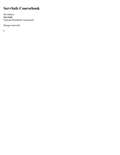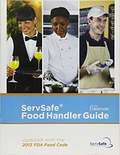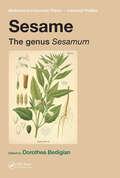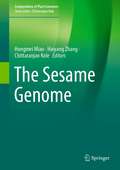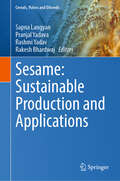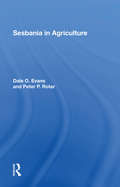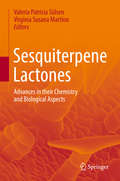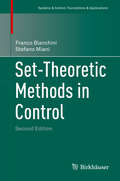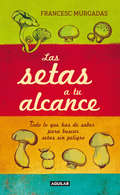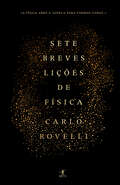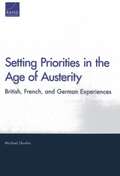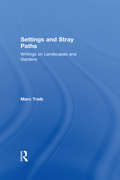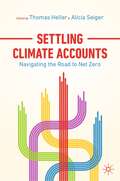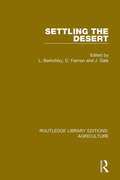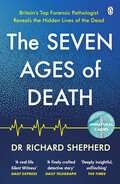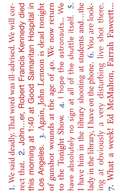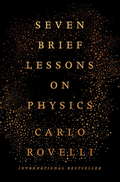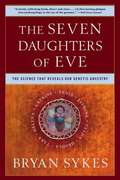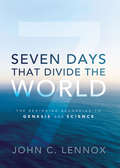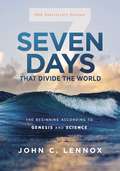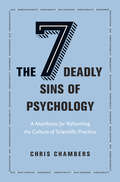- Table View
- List View
ServSafe Coursebook
by National Restaurant AssociationDelivering comprehensive training of key food safety concepts, SERVSAFE COURSEBOOK is the ideal solution for the academic setting, multiple-day training or individuals in need of more extensive food safety training. <p><P>The content in ServSafe Coursebook goes beyond the principles found in ServSafe Manager Book (formerly Essentials) and adds greater depth and breadth of food safety practices by featuring expanded sections on food defense, high-risk populations, active managerial control, and crisis management.
ServSafe Coursebook
by National Restaurant Association Educational FoundationThe information presented in the Course is provided for general educational and informational pur¬poses only and is not intended to provide legal, business or risk management advice to any party, and in no way represents advice with respect to specific practices of any party. Parties who develop policies and procedures based upon the materials in the Course are urged to obtain the advice and guidance of legal counsel with respect to their practices and local laws. Although the Association Entities endeavor to include accurate and current information compiled from sources believed to be reliable, the Asso¬ciation Entities and their affiliates, distributors, and agents make no representations or warranties as to the accuracy, currency, or completeness of the information in or available through the Course. THE INFORMATION IN OR AVAILABLE THROUGH THE COURSE IS PROVIDED "AS IS" WITHOUT WARRANTY OF ANY KIND, EITHER EXPRESS OR IMPLIED, INCLUDING BUT NOT LIMITED TO THE IMPLIED WAR¬RANTIES OF MERCHANTABILITY, FITNESS FOR A PARTICULAR PURPOSE, OR NON-INFRINGEMENT.
ServSafe CourseBook 7th Edition
by National Restaurant Association<P>Congratulations! By opening this book, you are joining millions of foodservice professionals in taking the first step in a commitment to food safety.<P> ServSafe® training helps you understand all of the food safety risks faced by your operation. <P>Once you're aware of these risks, you can find ways to reduce them.
Servsafe Food Handler Guide: Updated with the 2013 FDA Food Code
by National Restaurant National Restaurant AssociatioThe ServSafe Food Handler Guide 6th Edition easily integrates food safety into any existing onboarding training program. Sections can be completed in approximately 10 minutes. Color-coded sections for easy reference. Color photographs from the learners point of view helps reinforce food safety concepts <p><p> Enhanced assessment can be taken at the completion of training to measure if employees have the minimum competency in food safety knowledge.
Sesame: The genus Sesamum (ISSN)
by Dorothea BedigianThe first comprehensive review of sesame and its close relative, Sesame: the genus Sesamum covers ethnographic data, modern use, linguistic analysis of sesame names from around the world, market size, export and import data, geographical sources, use in the food and cosmetic industries, and much more. The book includes a historical review of the genus Sesamum that reveals its place in present-day traditions and cultivation in Africa and Asia. Expanding coverage from archaeological and anthropological literature from India, Mesopotamia, and Egypt, this ethnobotanical monograph draws on folk sources, reviews the phytochemistry of Sesamum, and presents extensive references.
The Sesame Genome (Compendium of Plant Genomes)
by Hongmei Miao Haiyang Zhang Chittaranjan KoleThis book is the first comprehensive compilation of deliberations on whole genome sequencing of sesame including genome assembly, annotation, structure and synteny analysis, and sequencing of its chloroplast genome and also its wild species. It presents narratives on classical genetics and breeding, tissue culture and genetic transformation, molecular mapping and breeding. Other chapters describe the beneficial components in sesame protein and oil, botanical depictions and cytological features. Prospects of designed breeding in the post-genomics era including gene discovery have also been enumerated.Altogether, the book contains 19 chapters authored by globally reputed experts on the relevant field in this crop. This book is useful to the students, teachers, and scientists in the academia and relevant private companies interested in classical and molecular genetics, biotechnology, breeding, biochemistry, traditional and molecular breeding, and structural and evolutionary genomics. The work is also useful to seed and oil industries.
Sesame: Sustainable Production and Applications (Cereals, Pulses and Oilseeds)
by Sapna Langyan Pranjal Yadava Rashmi Yadav Rakesh BhardwajThis edited book systematically discusses the advances in biotechnology, agrotechnology, and food technology in shaping sesame production, cultivation and uses to meet the future needs. Sesame (Sesamum indicum) is the oldest oilseed crop known to humans. It has been recognized as one of the most nutritious and health-supportive crops, with several applications in food, cosmetics, and health products. A wide variety of sesame is grown throughout the world, primarily in Asia and Africa. It’s seed and seed oil is being used widely in diverse cuisines. It is also used in cosmetic and health products. Advances in biotechnology, agrotechnology, and food technology in redefining sesame production and uses are of great importance. Various new advanced technologies have been employed to develop high yielding and disease resistant sesame varieties, for better cultivation, seed production, and for utilization of seeds and seed oil in a lot of foods, cosmetic, and health products. This book provides an overview of different advanced technologies, their mechanisms, and their effect on the quality of the sesame crop and sesame seeds/oil. The book also emphasizes the assessment of advanced technology on its limitations and advantages. This book offers the latest research on techniques, applications, and challenges of producing quality sesame crop with recommendations towards sustainable agriculture. The book is a valuable resource for students, researchers and scientists working in the field of sesame production and applications. Industry experts involved in development and management of sustainable production technologies will also find the book beneficial.
Sesbania In Agriculture
by Dale O. Evans Peter P RotarSesbania, a member of the legume family, has been the object of study in new efforts to discover, conserve, and use plant genetic resources. This volume brings together the most recent research on the subject and combines it with previous studies and an extensive review of the literature. This work is a synthesis of biological description and applied studies related to the highly variable and versatile Sesbania species. Sesbania occurs in both annual and perennial forms in tropical and subtropical regions and is adaptable to an unusually wide variety of soil conditions, including saline. The most important uses of the plants are in nitrogen fixation (as in green manures) and in cropping systems. Auxiliary uses of the different species are as sources for pulp fibers, fuel wood, animal fodder, and wind-breaks.
Sesquiterpene Lactones: Advances in their Chemistry and Biological Aspects
by Valeria Patricia Sülsen Virginia Susana MartinoThis book addresses chemical and biological aspects related to sesquiterpene lactones (STLs). Experts in different fields have been invited to contribute on this class of compound's chemistry, isolation and identification, biological activities (antibacterial, antifungal, antiviral, antitrypanosomal, antileishmanial,antiplasmodial, antiproliferative and antiinflammatory), synthesis, biosynthesis, derivatization and QSAR analysis. Taxonomic and chemotaxonomic aspects related to the Asteraceae family are also contributed. The book begins by describing the chemical characteristics of STLs, their classification in different skeleton types, synthesis, distribution in nature and their most important biological properties. An overview of the group's main representatives, based on their importance for human health, as well as an update of the most recently isolated STLs, follow. The authors also provide an overview of the most common methods described in the literature for the extraction, purification, identification and structure elucidation of STLs, while also highlighting more recently developed methods. Furthermore, experts in the field provide an in-depth discussion of the most commonly employed in vitro and in vivo antiprotozoal assays against the different stages of parasites, as well as STLs' properties as anticancer agents in numerous cancer cell lines and animal models. Lastly, the book presents examples of the in vitro and in vivo activity of STLs and their mechanism of antiprotozoal action, together with an analysis of ultrastructural alterations, observed using TEM techniques. The book is aimed at scientists working on natural products: both those investigating this particular group of compounds and those who wish to further explore its potential as new drugs for medical conditions such as protozoal diseases and cancer.
Set-Theoretic Methods in Control
by Franco Blanchini Stefano MianiThe second edition of this monograph describes the set-theoretic approach for the control and analysis of dynamic systems, both from a theoretical and practical standpoint. This approach is linked to fundamental control problems, such as Lyapunov stability analysis and stabilization, optimal control, control under constraints, persistent disturbance rejection, and uncertain systems analysis and synthesis. Completely self-contained, this book provides a solid foundation of mathematical techniques and applications, extensive references to the relevant literature, and numerous avenues for further theoretical study. All the material from the first edition has been updated to reflect the most recent developments in the field, and a new chapter on switching systems has been added. Each chapter contains examples, case studies, and exercises to allow for a better understanding of theoretical concepts by practical application. The mathematical language is kept to the minimum level necessary for the adequate formulation and statement of the main concepts, yet allowing for a detailed exposition of the numerical algorithms for the solution of the proposed problems. Set-Theoretic Methods in Control will appeal to both researchers and practitioners in control engineering and applied mathematics. It is also well-suited as a textbook for graduate students in these areas.
Las setas a tu alcance
by Murgadas, FrancescDescubre las variedades de setas, cómo identificarlas, cómo cocinarlas y conviértete en un experto micólogo. ¿Eres de los que sale al monte a buscar setas? ¿O prefieres adquirirlas en el supermercado? ¿Sabes reconocer las setas más preciadas? ¿Podrías identificar cuáles son venenosas? ¿Te gustaría saber cómo se cocinan? ¿Qué pasos hay que seguir para que conserven todo su sabor? El biólogo y catedrático en Ciencias Naturales Francesc Murgadas, experto en cocina, nos ofrece en Las setas a tu alcance todo lo que debemos saber para que nos familiaricemos con los conceptos fundamentales del mundo de la micología y la gastronomía de las setas. Cómo son las setas, cómo distinguir unas especies de otras, cómo se recolectan, cómo se cocinan, qué papel han tenido en la cultura de los pueblos y a qué leyendas y refranes han dado lugar.
Sete breves lições de Física
by Carlo Rovelli«A Física abre a janela para vermos longe.» «Que lugar temos nós, seres humanos que compreendem, decidem, riem e choram, neste grande fresco do mundo que a física contemporânea oferece? Se o mundo é um pulular de efémeros quanta de espaço e de matéria, um imenso jogo de encaixes de espaço e partículas elementares, o que somos nós? Somos também nós feitos apenas de quanta e partículas?» Ao longo de sete breves lições, Carlo Rovelli, físico italiano, guia o leitor, com admirável clareza e surpreendente poesia, numa viagem pela Física moderna, iluminando as suas descobertas mais marcantes e deixando entrever tudo aquilo que a Física ainda desconhece. Através das suas palavras, a Física deixa de ser uma abstracção acessível a poucos para ser parte da vida. Começamos viagem com «a mais bela de todas as teorias», a Teoria da Relatividade de Einstein, que abarca o tempo, o espaço e a compreensão do Universo. Seguimos para a mecânica quântica, outra teoria basilar, que decifra o comportamento da matéria. Passamos por paragens igualmente célebres - a teoria da gravidade, as partículas elementares, os buracos negros - e continuamos viagem para destinos ambiciosos - de que matéria é feito o espaço, qual a natureza do tempo, o que está na origem do cosmos, como funciona a mente humana. O local de chegada é o Homem e o seu lugar no Universo. Estudadas as sete lições, chegamos, inevitavelmente, mais perto daquilo que somos. «Somos feitos da mesma poeira das estrelas de que são feitas as coisas e, tanto quando estamos mergulhados na dor como quando rimos e a alegria resplandece, não fazemos senão ser aquilo que não podemos senão ser: uma parte do nosso mundo.»
Setting Priorities in the Age of Austerity: British, French, and German Experiences
by Michael ShurkinExamines the British, French, and German armies' approaches to accommodating significant budget cuts while attempting to sustain their commitment to full spectrum operations. Specifically, it looks at the choices these armies are making with respect to how they spend dwindling resources: What force structure do they identify as optimal? How much readiness do they regard as necessary? Which capabilities are they abandoning?
Settings and Stray Paths: Writings on Landscapes and Gardens
by Marc TreibThese collected works represent twenty-five years of study of the designed landscape which the author here takes to include gardens, cemeteries, plazas and other shared spaces. Asking essential questions about the nature of order and its perception, this book includes in its impressive scope analyses of both historic and modern works with a geographical distribution that extends across Europe, Asia and North America. With unique depth in many areas of study, Treib brings his expertise to bear on a range of inter-related and mutually influential issues within the subject, taking in an assessment of the lives and contributions of a number of leading figures in the field, the contents of a landscape and the meanings ascribed to it, and a theoretical formulation of the ideas from which or by which landscape architecture is produced.
Settlement, society and cognition in human evolution
by Francis Wenban-Smith Fiona Coward Robert Hosfield Matt PopeThis volume provides a landscape narrative of early hominin evolution, linking conventional material and geographic aspects of the early archaeological record with wider and more elusive social, cognitive and symbolic landscapes. It seeks to move beyond a limiting notion of early hominin culture and behavior as dictated solely by the environment to present the early hominin world as the outcome of a dynamic dialogue between the physical environment and its perception and habitation by active agents. This international group of contributors presents theoretically informed yet empirically based perspectives on hominin and human landscapes.
Settling Climate Accounts: Navigating the Road to Net Zero
by Thomas Heller Alicia SeigerAs drivers of climate action enter the fourth decade of what has become a multi-stage race, Net Zero has emerged as the dominant organizing principle. Hundreds of corporations and investors worldwide, together responsible for assets in the tens of trillions of dollars, are lining-up for the UN Race to Zero. This latest stage in the race to save civilization from heat, drought, fires, and floods, is defined by steering toward zeroing out greenhouse gas emissions by 2050. Settling Climate Accounts probes the practice of Net Zero finance. It elucidates both the state of play and a set of directions that help form judgements about whether Net Zero is going to carry climate action far enough. The book delves into technical analyses and activates the reader’s imagination with narrative accounts of climate action past, present, and future. Settling Climate Accounts is edited and authored by Stanford University faculty and researchers. The first part of the book investigates the rough edges of Net Zero in practice, exploring questions of hedging risk, Scope 3 emissions, greenwashing, and the business of asset management. The second half looks at states, markets, and transitions through the lenses of blended finance, offsets, debt, and securitization. The editors tease out possible solutions and raise further questions about the adequacy and reach of the Net Zero agenda. To effectively navigate the road ahead, the editors call out the need for accountability and ask: who is in charge of making Net Zero add up? Settling Climate Accounts offers context and foundation to ground the rapidly evolving practice of Net Zero finance. Targeted at seasoned practitioners, newly activated leaders, educators, and students of climate action the world over, this book embraces the complexity of climate action and, in so doing, proposes to animate and drive hope.
Settling the Desert (Routledge Library Editions: Agriculture #16)
by L. Berkofsky D. Faiman J. GaleFirst published in 1981. Settling the Desert is an attempt to organise those aspects of scientific and sociological research that are the necessary prerequisites for making the desert a comfortable and profitable place for man to inhabit. In this book, experts from many fields of desert research review the history of desert settlement and agriculture, as well as the present problems encountered by modern desert settlers. Topics discussed include: meteorology, sociology, ecology, water resources, solar energy, innovative desert agriculture, architecture, and animal science.
The Seven Ages of Death: ‘Every chapter is like a detective story’ Telegraph
by Dr Richard ShepherdThe heart-wrenchingly honest new book about life and death from forensic pathologist and bestselling author of UNNATURAL CAUSES, Dr Richard ShepherdA TIMES AND SUNDAY TIMES BOOK OF THE YEAR'Deeply insightful. Unflinching' THE TIMES'A finely-crafted detective story' DAILY TELEGRAPH'Enlightening, strangely uplifting' DAILY MAIL'Fascinating' DAILY EXPRESS_________Dr Richard Shepherd, a medical detective and Britain's top forensic pathologist, shares twenty-four of his most intriguing, enlightening and never-before-told cases.These autopsies, spanning the seven ages of human existence, uncover the secrets not only of how a person died, but also of how they lived.From old to young, murder to misadventure, and illness to accidental death, each body has something to reveal - about its owner's life story, how we age, justice, society, the certainty of death.And, above all, the wonderful marvel of life itself._________Praise for Dr Richard Shepherd'Gripping, grimly fascinating, and I suspect I'll read it at least twice' Evening Standard'A deeply mesmerising memoir of forensic pathology. Human and fascinating' Nigella Lawson'An absolutely brilliant book. I really recommend it, I don't often say that but it's fascinating' Jeremy Vine, BBC Radio 2'Puts the reader at his elbow as he wields the scalpel' Guardian'Fascinating, gruesome yet engrossing' Richard and Judy, Daily Express'Fascinating, insightful, candid, compassionate' Observer
Seven American Deaths and Disasters
by Kenneth GoldsmithIn Seven American Deaths and Disasters, Kenneth Goldsmith transcribes words used by people describing events they had never prepared themselves to witness, as they unfurl. In doing so, he reveals an extraordinarily rich linguistic panorama of passionate description. Taking its name from the Warhol paintings of the same name, Goldsmith recasts the mundane as the iconic, creating a sense of prose poems that encapsulate both the Kennedy assassinations, that of John Lennon, the Space Shuttle Challenger disaster, 9/11 and the death of Michael Jackson.
Seven and a Half Lessons About the Brain
by Prof. Lisa Feldman BarrettFrom the author of How Emotions Are Made, a myth-busting primer on the brain in the tradition of Seven Brief Lessons on Physics and Astrophysics for People in a Hurry. Have you ever wondered why you have a brain? Let renowned neuroscientist Lisa Feldman Barrett demystify that big gray blob between your ears. In seven short essays (plus a bite-sized story about how brains evolved), this slim, entertaining, and accessible collection reveals mind-expanding lessons from the front lines of neuroscience research. You'll learn where brains came from, how they’re structured (and why it matters), and how yours works in tandem with other brains to create everything you experience. Along the way, you’ll also learn to dismiss popular myths such as the idea of a &“lizard brain&” and the alleged battle between thoughts and emotions, or even between nature and nurture, to determine your behavior. Sure to intrigue casual readers and scientific veterans alike, Seven and a Half Lessons About the Brain is full of surprises, humor, and important implications for human nature—a gift of a book that you will want to savor again and again.
Seven Brief Lessons on Physics
by Carlo Rovelli<P>The international bestseller that reveals all the beauty of modern physics in seven short and enlightening lessons. <P> Seven Brief Lessons on Physics is a book about the joy of discovery. <P>Carlo Rovelli brings a playful, entertaining, and mind-bending introduction to modern physics, offering surprising--and surprisingly easy to grasp--explanations of general relativity, quantum mechanics, elementary particles, gravity, black holes, the complex architecture of the universe, and the role humans play in this weird and wonderful world. <P>He takes us to the frontiers of our knowledge: to the most minute reaches of the fabric of space, back to the origins of the cosmos, and into the workings of our minds. <P>"Here, on the edge of what we know, in contact with the ocean of the unknown, shines the mystery and the beauty of the world," Rovelli writes. "And it's breathtaking." <P><b>A New York Times Bestseller</b>
The Seven Daughters of Eve
by Bryan SykesThe identification of a snippet of DNA in mitochondria allows scientists to trace our maternal genetic makeup back to prehistoric times.
Seven Days That Divide the World: The Beginning According to Genesis and Science
by John C. LennoxWhat did the writer of Genesis mean by “the first day”? Is it a literal week or a series of time periods? If I believe that the earth is 4.5 billion years old, am I denying the authority of Scripture? In response to the continuing controversy over the interpretation of the creation narrative in Genesis, John Lennox proposes a succinct method of reading and interpreting the first chapters of Genesis without discounting either science or Scripture. With examples from history, a brief but thorough exploration of the major interpretations, and a look into the particular significance of the creation of human beings, Lennox suggests that Christians can heed modern scientific knowledge while staying faithful to the biblical narrative. He moves beyond a simple response to the controversy, insisting that Genesis teaches us far more about the God of Jesus Christ and about God’s intention for creation than it does about the age of the earth. With this book, Lennox offers a careful yet accessible introduction to a scientifically-savvy, theologically-astute, and Scripturally faithful interpretation of Genesis.
Seven Days that Divide the World, 10th Anniversary Edition: The Beginning According to Genesis and Science
by John C. LennoxNow revised and updated--John Lennox's acclaimed method of reading and interpreting the first chapters of Genesis without discounting either science or Scripture. What did the writer of Genesis mean by "the first day?" Are the seven days in Genesis 1 a literal week or a series of time periods? If I believe that the earth is 4.5 billion years old as cosmologists believe, am I denying the authority of Scripture?With examples from history, a brief but thorough exploration of the major interpretations, and a look into the particular significance of the creation of human beings, Lennox suggests that Christians can heed modern scientific knowledge while staying faithful to the biblical narrative. He moves beyond a simple response to the controversy, insisting that Genesis teaches us far more about the God of Jesus Christ and about God's intention for creation than it does about the age of the earth.With this book, Lennox offers a careful and accessible introduction to a scientifically-savvy, theologically-astute, and Scripturally faithful interpretation of Genesis.Since its publication in 2011, this book has enabled many readers to see that the major controversy with which it engages can be resolved without compromising commitment to the authority of Scripture. In this newly revised and expanded edition, John clarifies his arguments, responds to comments and critiques of the past decade since its first publication. In particular, he describes some of the history up to modern times of Jewish scholarly interpretation of the Genesis creation narrative as well as spelling out in more detail the breadth of views in the Great Tradition of interpretation due to the early Church Fathers. He shows that, contrary to what many people think, much of the difficulty with understanding the biblical texts does not arise from modern science but from attempting to elucidate the texts in their own right.
The Seven Deadly Sins of Psychology: A Manifesto for Reforming the Culture of Scientific Practice
by Chris ChambersWhy psychology is in peril as a scientific discipline—and how to save itPsychological science has made extraordinary discoveries about the human mind, but can we trust everything its practitioners are telling us? In recent years, it has become increasingly apparent that a lot of research in psychology is based on weak evidence, questionable practices, and sometimes even fraud. The Seven Deadly Sins of Psychology diagnoses the ills besetting the discipline today and proposes sensible, practical solutions to ensure that it remains a legitimate and reliable science in the years ahead.In this unflinchingly candid manifesto, Chris Chambers draws on his own experiences as a working scientist to reveal a dark side to psychology that few of us ever see. Using the seven deadly sins as a metaphor, he shows how practitioners are vulnerable to powerful biases that undercut the scientific method, how they routinely torture data until it produces outcomes that can be published in prestigious journals, and how studies are much less reliable than advertised. He reveals how a culture of secrecy denies the public and other researchers access to the results of psychology experiments, how fraudulent academics can operate with impunity, and how an obsession with bean counting creates perverse incentives for academics. Left unchecked, these problems threaten the very future of psychology as a science—but help is here.Outlining a core set of best practices that can be applied across the sciences, Chambers demonstrates how all these sins can be corrected by embracing open science, an emerging philosophy that seeks to make research and its outcomes as transparent as possible.
